Researchers have confirmed that pyrethroid resistant cabbage stem flea beetles are present in the UK. This information is vital for oilseed rape growers who are already sowing crops following this year’s early harvest.
Work carried out by Rothamsted Research, as part of HGCA Project 214–0019, shows that knock down resistance (KDR) is found in UK populations of cabbage stem flea beetle. KDR usually confers moderate resistance to all pyrethroids applied at recommended field rates. Following the restriction on neonicotinoid seed treatments, controlling cabbage stem flea beetle will be reliant on pyrethroid insecticides, so control may be more challenging this season.
“Samples for testing were sent in mainly from the South East so we don’t know how widespread the resistant populations are. It is therefore possible that the KDR mutation is localised making resistance management a priority this autumn.
“Close monitoring will be crucial this season and the presence of KDR is an added complication. It is therefore essential to only apply a pyrethroid spray where it is absolutely necessary in order to prevent the spread of resistance.” explains HGCA’s Caroline Nicholls.
“Research from ADAS (HGCA Project 214–0009) has shown that oilseed rape can cope with severe shot holing even at the cotyledon stage. This demonstrates that the crop is most vulnerable at emergence where any damage to the growing tip can be lethal. It is this type of damage, at emergence, that can wipe out an entire crop.”
It is prohibited to use pyrethroids on bare soil, so the spray window for treating at emergence is quite narrow. There are no set spray thresholds at emergence but monitoring local pest pressure will give an indication of whether it is necessary. There are three ways to monitor pest pressure:
The appearance of KDR underlines that good establishment and a fast getaway for the crop is more important than ever given the reduced number and efficacy of pesticides. It is important to pay attention to a wide range of factors such as soil moisture, temperature, seed rate, variety and fertiliser choice to give the crop the best possible start.
Read more HERE.
 |
| Shot-holing damage at the seedling stage: photo copyright Dewar Crop Protection |
Work carried out by Rothamsted Research, as part of HGCA Project 214–0019, shows that knock down resistance (KDR) is found in UK populations of cabbage stem flea beetle. KDR usually confers moderate resistance to all pyrethroids applied at recommended field rates. Following the restriction on neonicotinoid seed treatments, controlling cabbage stem flea beetle will be reliant on pyrethroid insecticides, so control may be more challenging this season.
“Samples for testing were sent in mainly from the South East so we don’t know how widespread the resistant populations are. It is therefore possible that the KDR mutation is localised making resistance management a priority this autumn.
“Close monitoring will be crucial this season and the presence of KDR is an added complication. It is therefore essential to only apply a pyrethroid spray where it is absolutely necessary in order to prevent the spread of resistance.” explains HGCA’s Caroline Nicholls.
“Research from ADAS (HGCA Project 214–0009) has shown that oilseed rape can cope with severe shot holing even at the cotyledon stage. This demonstrates that the crop is most vulnerable at emergence where any damage to the growing tip can be lethal. It is this type of damage, at emergence, that can wipe out an entire crop.”
It is prohibited to use pyrethroids on bare soil, so the spray window for treating at emergence is quite narrow. There are no set spray thresholds at emergence but monitoring local pest pressure will give an indication of whether it is necessary. There are three ways to monitor pest pressure:
- Checking the number of cabbage stem flea beetles in the previous crop’s harvested seed
- Using water traps to check beetle numbers
- Assessing damage to volunteer oilseed rape plants
- Cotyledon – 2 true leaves: consider spraying when 25% of the green leaf area of the whole crop has been eaten
- 3–4 leaf stage: consider spraying when 50% of the green leaf area of the whole crop has been eaten
The appearance of KDR underlines that good establishment and a fast getaway for the crop is more important than ever given the reduced number and efficacy of pesticides. It is important to pay attention to a wide range of factors such as soil moisture, temperature, seed rate, variety and fertiliser choice to give the crop the best possible start.
Read more HERE.
The Global Miller
This blog is maintained by The Global Miller staff and is supported by the magazine GFMT
which is published by Perendale Publishers Limited.
For additional daily news from milling around the world: global-milling.com

No comments:
Post a Comment